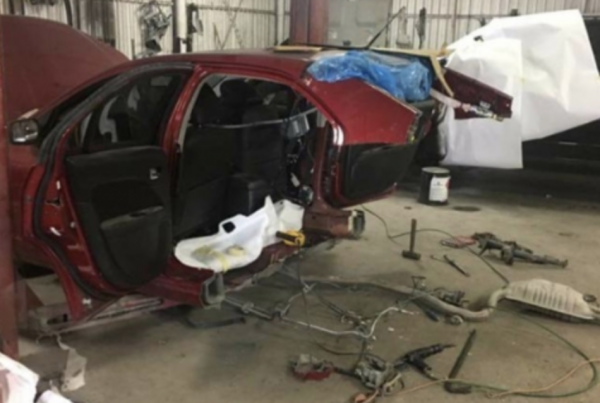The bottom line, a body shop should never replace your damaged quarter panel with a used one from a donor vehicle. But guess what, many of them do. Even though a quarter panel is not considered a structural component with regards to the vehicle structure, they do interact with the structural components.
Car repair has had a lot of changes over the past few years. The push for more repair shops to utilize OEM recommendations has brought to light just how important it is for technicians to follow these repair procedures. However, some shops don’t care about the reason why specific OEM repair procedures are released. They’ll approach a repair from “experience,” often cutting corners in the repair process. Or worse, they are looking to cut corners in order to maintain a profit while being squeezed by the insurance companies who refuse to pay for certain steps. Thus, putting you at risk of getting injured in a second accident and the advanced safety features in your car to no longer function properly.
According to Vehicle Collision Experts CEO Mark Olson, “how the OEM built the vehicle and how you fix it might not be the same, and a repairer can’t assume that duplicating what they saw on the vehicle will work.” A technician can never assume in the repair process, and yet, many do. They think repairing the vehicle quickly is what matters, but there’s a catch. Technicians who repair a car without consulting the manufacturer’s procedure pages are essentially only putting a bandaid on the repair. However, proper repair fixes whatever problems the car had to last the lifetime of the vehicle.
Approaching Repair On Quarter Panels
Let’s take, as an example, repairs for quarter panels. The Original Equipment Manufacturer (OEM for short) of your vehicle has specific repair requirements for technicians to follow. Your car’s manufacturer assumes a technician would be using an entirely new panel, not a donor/used one with existing weld nuggets from the car it was removed from. Approaching this type of repair on quarter panels, a technician needs to go through the following checklist:
- What’s it made of?
- What’s it attached to?
- Sectioning location?
- Attachment methods (such as remove and replace)?
- How do you remove the panel?
- Supporting materials?
- Required tooling and equipment?
The Controversy Behind Quarter Panel Repairs
So why exactly is all this commotion over quarter panel repairs? For one, the IIHS constitutes this type of repairs as cosmetic. However, quarter panels are vital to the overall structural integrity of your vehicle. Also, cars that are made out of metals beyond steel will often require welding (i.e., heat). If technicians replace the quarter panel on your car with a used quarter panel, the plug weld will be too big.
Olson also stated, “any holes drilled in a used quarter panel might be 10 mm, perhaps 10.5 after deburring. As the OEM wants only 8 mm plug welds, it’s officially impossible to deliver the repair with a used quarter panel.”
Bigger welds are not better when it comes to collision repair. Some technicians will argue, “when this thing gets hit, it’ll never break.” However, it’s not about that. It’s about repairing the vehicle exactly how the OEM said to do it.
Used quarter panels have been tempered with or heated multiple times in the welding process, more than you’d ever see on a new quarter panel. It doesn’t take a well-trained technician to see used quarter panels can’t provide the same level of safety a new quarter panel would.
Other Reasons Why Used Quarter Panels Won’t Work
As stated in Repairer Driven News, a second reason why used quarter panels wouldn’t work is because of the inability to follow OEM repair procedures. Repairer Driven News also stated, “…the idea of producing holes (such as spot welds on a quarter panel) outside of OEM tolerances also means the repair would be a nonstarter.”
A third reason would be due to something known as “work hardening.” What this means is some quarter panels are installed with rolled hem flanges that have eventually been work-hardened. This happens when the metal is unrolled and rerolled to the point where it can’t be rolled back out. It’s like twisting a paper clip over and over until eventually, it weakens, and the metal clip is destroyed. This the process of work hardening on used quarter panels.
To learn more about what’s wrong with used quarter panels, check out this video from Collision Hub that goes in-depth about these repairs.
Who In New Jersey Knows How To Perform Quarter Panel Repair The Right Way?
We at Rocco’s Collision Center know how car repair can be extremely stressful, which is why we’re here to help you with all of your repair needs. Our team of technicians have received extensive training from I-CAR and are fully aware of the importance of OEM related repairs. Our goal is to provide an exceptional product to every single customer with unparalleled hospitality and knowledge throughout the entire collision repair process.
We have seven different locations across Philadelphia and Southern New Jersey. We know you have several choices when looking for an auto body shop, but we feel quite confident we will exceed your expectations. For a list of numbers and addresses to each one of our locations, click here. Or, feel free to give us a call at anytime at (888)-9-ROCCOS.
We look forward to hearing from you!




